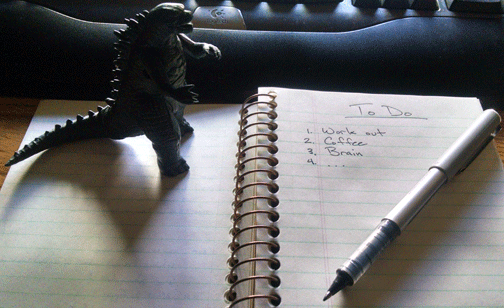Over the past few weeks, I’ve been working to change my morning routine. The goal is to get up early and sneak in a workout before my day gets rolling and I have to focus on braining for a living. The reality has turned out to be a bit of a challenge.
Routines are the foundation of my mind; they keep me sane, focused, productive, and most importantly, happy. Unfortunately, they can also be a massive pain to adjust. Ask anyone who’s tried to add exercise or breakfast to a morning routine. They’ll back me up. So will all the people who have tried to start using productivity software. Even something simple like working in a to-do list each morning can be surprisingly difficult (see Figure 1).

If it isn’t something you already do, trying to train yourself to start often ends in tears.
The Little Things
The past few years of life changes have introduced some sneaky routine alterations. For example: one morning, Brian commented on how much he liked it when I made the bed early. I realized then that it had worked its way into my mornings without a hint of frustration or difficulty. My best routines seem to evolve naturally over time with no consternation on my part, and that led me to write this post.
These evolutionary changes fold into my routine so well because they piggyback onto other tasks I already do every morning, such as opening the curtains and feeding the fish. That’s a solid strategy for picking up other little things I know I should be doing, like moisturizing consistently. I haven’t managed that one yet. But for those bigger things, like rewriting my morning to work in some cardio, I’ve got to look at it differently.
Schedules, Yay!
Schedules are our friends: they help us plan and organize our tasks (of which I’m a big fan) to make sure we tackle everything we need to do. They’re easy to make. Why are they so hard to keep? Because we forget to be realistic. I think most people approach scheduling with the bizarre enthusiasm that accompanies New Year’s resolutions. People tend to forget reality when coming up with those too.
It’s easy to go overboard when setting up a new routine and not think about how I’m going to feel when the time comes to execute, or how I’ll feel six months down the road. “Heck yeah, every day I’ll roll right out of bed and onto the exercise bike for 30 minutes at six in the morning with no coffee!” Then the alarm clock goes off, I realize the house is cold, and my brain says, “Haha, nope,” which derails the entire agenda. This happens because I threw in too many components.
My solution is to think in baby steps: make the changes more evolutionary instead of revolutionary.
Yes, Baby Steps
I am just as guilty of towering impatience as the next person (more so, actually), so baby steps have been particularly difficult for me to accept. For example, I hate taking breaks during projects; I want to finish what I’m doing and move on to the next task. Breaks hinder that process and therefore piss me off. In establishing new routines, baby steps mean slow progress. Slow progress means I’m not there yet; therefore baby steps piss me off. As frustrating as it is, they’re sometimes the only thing that works.
Take my exercise goal above; I’ve combined getting up earlier with adding exercise out of nowhere while delaying my wake-up juice. That is a recipe for pain, not only for me, but the unfortunates who live with me as well. A better way to do this without our kitchen becoming a crime scene is to work on waking up earlier first, and do it slowly over a couple of months. Now that I’m used to getting up at six, I can either have my coffee before hitting the bike, or start working on delaying the coffee. I’ll break it into steps, which will help me see sustainable progress.
Sustainability is the reason baby steps are a thing.
Let Me Sum Up
I actually get an eye tic when I can’t follow my routine, so take my experience for what it is: personal. What works for me won’t work for everybody, but it might give you a place to start if you’re working on a similar change.
- Piggyback – Add small tasks to routines you’ve already established. If you want fewer chores in the evening, wash the breakfast dishes before heading out the door.
- Evolve, Baby! – Make evolutionary changes to your routine rather than revolutionary ones. If you want to cook more and eat out less during the week, start with one meal and work up from there.
- Track Progress – Make a concentrated effort to notice and track your progress. Being conscious of it will keep you from getting discouraged when you’re not there yet.
Do you baby-step your way into a new routine, or do you cannonball? Let us know in the comments. I’ll just be here updating my schedules and attacking my to-do list.
*Footnote: The Ork (Brian Landis) came up with the revolutionary to evolutionary lingo because he’s freaking awesome like that. I had just been calling it “piggybacking.” Lurve.

